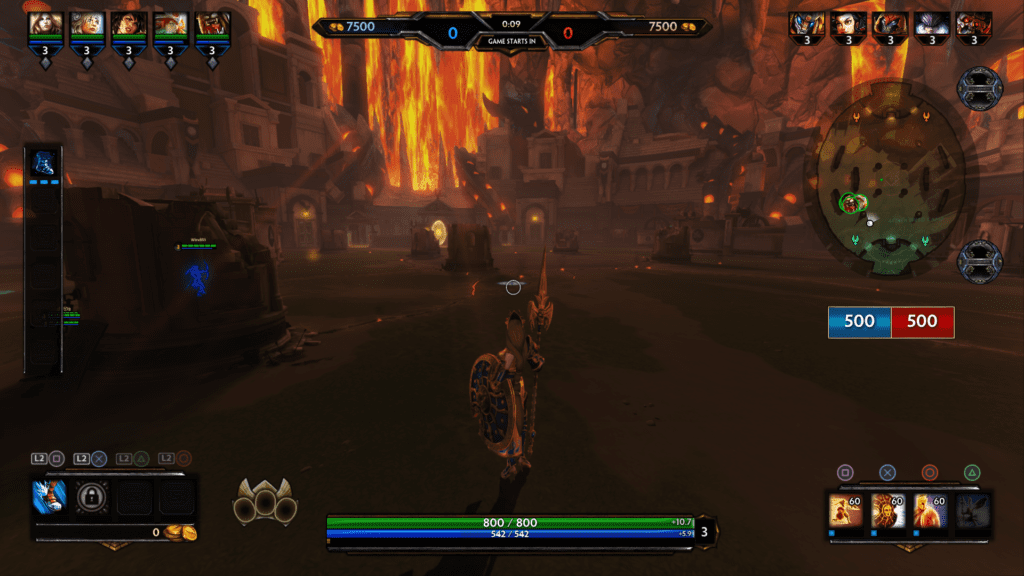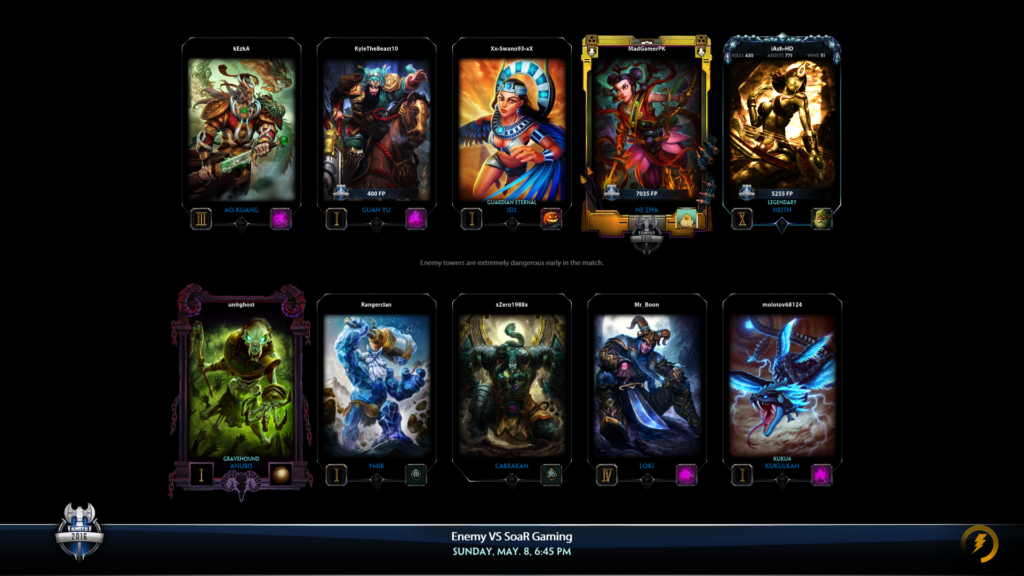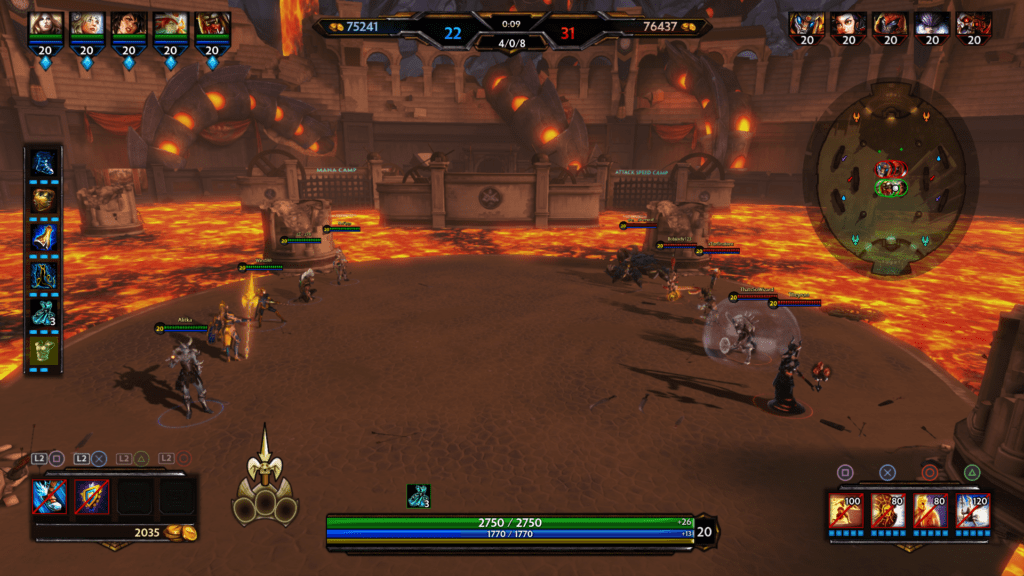The extent of my knowledge of MOBAs doesn’t reach particularly far. Even at a sufficient distance from the ever-flourishing genre and the zealous culture that clings to it, I wasn’t able to remain completely blind to its influence. I may have successfully sidestepped the dawn of the MOBA era, but here I was, pondering an unknowing plunge into the black at the peak of its popularity. What I did know, I couldn’t exactly apply to Smite. MOBAs, or Multiplayer Online Battle Arenas, are characterised by a deep understanding of every bolt and cog that exists at the heart of the machine. To take a base view of a MOBA is to understand what it is, but not what makes it work. And to lack a clear comprehension of every one of the small intricacies within is enough to see prospective aspirations harshly beaten into the ground.
The introductory period then is a little tough. And the majorly popularised aspects of the MOBA landscape lend little to the image of amateurism, either. Teams of young professionals huddle around beckoning monitors atop a softly illuminated centre stage. There, in front of a baying crowd of thousands, every click and decisive key press is met with contrasting nods of approval and grimaces of dismay. The victorious then stand rooted beneath the flittering bushels of confetti as the enraptured arena rises again to the fore, their success forever immortalised within the digital pantheon of both their conquered game and its many contemporaries. The reverence that surrounds modern MOBAs is astounding, but for someone blind to it all, it’s also a little unnerving.
To see the modern scape of competitive gaming propelled by such a tireless following unearthed a few shades of underlying anxiety in me. I wasn’t contemplating a shift towards my first MOBA for the sake of revitalising my Twitch follower count or cultivating sponsorship deals. I was doing it for the same reason as with any other game – a desire to experience something different. And unlike my initial thoughts upon first reading that Smite was heading to the PlayStation 4, my own grasp of the games many nuances was now the furthest thing from my mind. At the point of unravelling a little bit more of the world I was about to enter, it was now about whether or not I would simply get it. The meta-game, the Gods, the patch notes, the developers, the competition, the past, the future, the fanaticism and the significance of it all. To stand at Smite’s edges was, by extension, to stand at the edges of an entire genre that dwarfed my comprehension. And to have played video games for such a long time, only to be left completely oblivious by the unassuming emergence of a completely different beast is nothing if not sobering.
For my first relic, I chose Sprint. “More ways to escape” I’d think to myself. Initial skirmishes across a handful of Arena matches had shown me of the chaos inherent to many of Smite’s larger scale battles, and the heightened levels of danger that they command. Before familiarising myself with the viability of a well-timed retreat, typical fights would see me initiate combat with a Guardian, only to be struck by a quintet of finishing moves and torn apart by the razor-sharp teeth of each encircling jackal. Perhaps there was more to being a Hunter than just racking up a high death count. If I had any advantage at all though, it was my contented history with many storied first-person shooters. My younger years were largely spent in a prolonged stupor, heavily engrossed as I was by the likes of the Modern Warfare series, and by Bungie’s masterful Halo 3. My common interest across all of those games was in dispatching foes from range, and in having them curse my existence without so much as knowing from which shrouded hovel that I had struck. All of my greatest badges of honour were earned whilst verbally commending myself for a particularly exquisite feat of marksmanship, much to the annoyance of any allies in earshot. And it was only through an extended amount of time spent with a certain Egyptian world-weaver that I came to realise that not much has changed since.
Smite, in differentiating itself from the competition, trades an isometric viewpoint for a closer, third-person perspective. This adds a layer of freneticism to every bit of action, and makes every little jab at an enemy seem more edge-of-your-seat captivating. You weren’t just watching your chosen God be consumed by a maelstrom of strikes – you were being thrown into the air, carried away between a set of jaws and devoured by dragons, just as they were. And in executing your own Ultimate Attack, or ‘Ult’, you were doing the very same to them. Neith’s Ultimate catered to my love of damning finality all too well. A lone bolt through the heart, a piercing crack in the dark. The first time I ever executed it successfully, my target was in the process of teleporting back to the fountain, carrying the telltale signs of a battle almost lost – a health bar more black than red, a hasty exit via a lane typically free from prying eyes. They couldn’t possibly have noticed the spinning Ward painting their crimson silhouette against the nearest wall. The wait between the release of my arrow and the sound of crashing coins almost seemed like an eternity. First Blood!…
* * *
But it was relieving to find a God on the roster that I could keep up with. I had dabbled in a few others prior without ever really grasping the varying play-styles specific to each of them. I couldn’t get a handle on the burst attacks of Amaterasu, couldn’t muster enough balance between the offensive and defensive sides of Ares. In lieu of hastily retiring Neith when I was still far from being rid of my training wheels, my familiarity with her at least gave me the chance to explore the breadth of the item building mechanic for the first time. There was only so far that the ‘Recommended’ tab could take me, anyway.
Matches thereafter served as workshops for the chopping and changing of items that I could permanently bind to my Neith build. I needed movement speed for both feats of escapism and for attacking rooted targets – the Warrior Tabi boots seemed like a perfect fit. Attack speed would be required too – Odysseus’ Bow to start, Ichaival’s Bow to follow. But speed without damage is worthless, and so the critical-centric pairing of Rage and Deathbringer would complete the template for my aggressive, domineering take on Neith. The aforementioned cogs of the Smite machine are ever churning though, and so outlined builds count for nought when measured against the notion of situational awareness. The first time I learned that, I came up against a particularly nasty Sobek, who, after growing tired of scores of my arrows reverberating off of his impenetrable hide, would simply throw me over his shoulder into the clutches of a waiting team. It decided the entire match. I wasn’t able to adapt, and so I perished. Approaching this as if it were an FPS, I redeployed the very same strategy in the following match, only this time trading what little movement speed that I had in for a dull bludgeoning tool that excelled my raw attack power that little bit more. But the columns that Sobek once patrolled were this time occupied by a stoutly-standing Loki. My eleventh minute surrender proposal was promptly rebuked.
I suppose that was one of the more difficult things to get my head around – the bigger stick isn’t necessarily the best. To adorn your God with every sword and stave under the sun is a viable tactic – but it isn’t the only tactic. You need to factor in the game mode, your opponents, the composition of their team, the balance of yours. But you’ve got to be open to change, for with change comes passive improvement, and with improvement comes confidence. The weeks passing since Smite first launched on the PlayStation 4 succeeded in breeding an arrogance in me. Before, I’d wave away the final scoreboard content in already knowing the outcome of the match. But now I’m scrutinising the builds of others. “Here’s why you died, Thor” I’d quip. “What were you thinking, Vulcan?” The very next match, that same Vulcan would stain the marble archways with my blood while showing little remorse. I could hardly blame him.
I was lucky enough to find myself as part of a quartet that regularly trawled through Smite’s playlists in search of a challenge. And of course, when that challenge presented itself, it was usually met with bellowing condemnations of free-flying Odin’s and imperious Loki’s. We were a good team, though. At our head was the only experienced MOBA player among us, a former League of Legends skirmisher who espoused confidence and an impressive understanding of the games inner-workings. “It’s just the meta” he’d say when doling out roles at the start of every match of Conquest. The meta-game of Smite dictated the positions of each player on the team in matches outside of the Arena, and in Conquest, a game mode that required just as much regimentation as it did time invested, adherence to the meta-game largely decided the victor. It was the grease that kept the wheels spinning, the unwritten rules at the heart of the game. And just like much of Smite’s collective teachings, it was passed down by others rather than read from a manual.
* * *
“Warrior in the left lane, Assassin in the jungle, Mage in the middle”. I was the winged serpent Kukulkan now, and my job, my only job, was to oversee the defence of the middle lane as my team carved their way through the adjacent channels. So I threw a tornado down and culled any onrushing minions. I drank down gallons of liquid power and edged my battalion forward. And as a war was waged around me, I did nothing but tend to the task of clearing my lane. Yet so fixated was my gaze on my own objective that I hadn’t noticed our towers crumble into dust out on the flanks. Our Titan would fall to its knees soon enough. For even with all of the pieces in the right positions, you still have to make the right moves. In the wake of the commencement of my Smite career, I’ve seen meta termed as an acronym: the most efficient tactics available. It’s ever-changing, then. A series of permeable rules that are defined by the trials and tribulations of the community. Maybe a Warrior might not be greatest choice for a side lane at some point in the future. Maybe my Kukulkan will be quashed by an uprising of Assassins. Maybe all of that has already happened. The meta of Smite is but a single one of its tectonic plates – defined and understood, but moving and malleable. And, as I was beginning to realise, to not keep up with the constant alterations of the game on each of its many levels was to risk being left in its wake.
Smite is forever rewriting itself because it has to. So multifaceted is it in every aspect, that the prospect of stagnating could be tantamount to a death sentence. Immersed within the competitive sphere from the very beginning, Smite’s finely attuned core lends itself to community tournaments, casual cooperative jaunts and professional play, all in equal measure. A single misstep is thus felt threefold, with the weekend skirmisher being just as susceptible to any breakage as the cultured e-sport commander. Far more obvious however is its need to remain popular. The MOBA genre is, as of yet, far from being totally oversaturated, but the market continues to foster healthy competition. Such are Smite’s shared similarities with its contemporaries, that the success of one game will always be measured against the other. They all have their championship trophies, their resident streamer contingent. And similarly to new players like myself, they all survive through the necessity of adaptation.
And it’s through my own personal maturation that I’ve arrived at something of a roads end with Smite. I’m comfortable with my own play-style, my own tendencies. After Sprint comes Sanctuary, except when the context demands a deadly Sunder or a burst of Frenzy. I know of the meta-game, the lexis and the immediate disrespect that comes with certain successes. “Eres bomitivo marikon cobarde!” as one particularly aggrieved Spaniard put if after I repeatedly cocooned his Tyr with the delicately weaved threads of a Neith root. And I may have even dipped a toe into the tepid waters of competitive fandom, although I still don’t understand exactly what the clown team keep doing wrong.
The end of the road isn’t met with a blockade however. My tastes have changed over the years, with few multiplayer titles managing to hold my attention just as firmly as those aforementioned FPS games. Yet Smite sits comfortably even as my backlog of games continues to grow around it. The testament of a good game is a satisfying conclusion to a wonderful journey. The testament of a great game is that its every virtue occupies your mind long after you’ve powered down. And since I’ve begun playing Smite, there hasn’t been a time yet when an aimless gaze out of the bus window hasn’t masked the assemblage of a new character build. There’ll come a time soon when Smite sits dormant for a while. Certain other game releases will take precedence, as they should. But even as I take the reins as Nathan Drake for one final time, my pulse will still beat in tandem with all emerging changes that affect the MOBA on which I cut my teeth. I still don’t think I’ll ever understand the crux of it all, but I’m glad to have been a part of it anyway.


